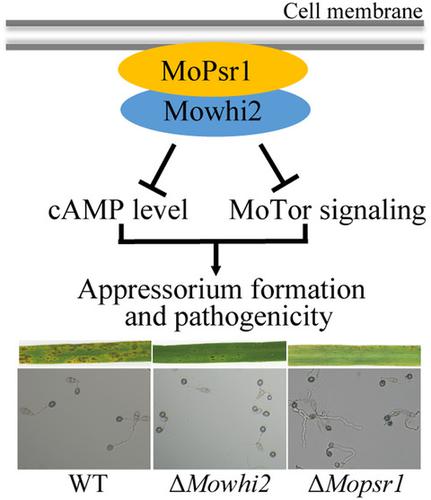当前位置:
X-MOL 学术
›
Mol. Plant Pathol.
›
论文详情
Our official English website, www.x-mol.net, welcomes your
feedback! (Note: you will need to create a separate account there.)
MoWhi2 regulates appressorium formation and pathogenicity via the MoTor signalling pathway in Magnaporthe oryzae
Molecular Plant Pathology ( IF 4.8 ) Pub Date : 2021-05-25 , DOI: 10.1111/mpp.13074 Huanbin Shi 1 , Shuai Meng 1, 2 , Jiehua Qiu 1 , Congcong Wang 1 , Yazhou Shu 1 , Chaoxi Luo 2 , Yanjun Kou 1
Molecular Plant Pathology ( IF 4.8 ) Pub Date : 2021-05-25 , DOI: 10.1111/mpp.13074 Huanbin Shi 1 , Shuai Meng 1, 2 , Jiehua Qiu 1 , Congcong Wang 1 , Yazhou Shu 1 , Chaoxi Luo 2 , Yanjun Kou 1
Affiliation

|
Magnaporthe oryzae causes rice blast disease, which seriously threatens the safety of food production. Understanding the mechanism of appressorium formation, which is one of the key steps for successful infection by M. oryzae, is helpful to formulate effective control strategies of rice blast. In this study, we identified MoWhi2, the homolog of Saccharomyces cerevisiae Whi2 (Whisky2), as an important regulator that controls appressorium formation in M. oryzae. When MoWHI2 was disrupted, multiple appressoria were formed by one conidium and pathogenicity was significantly reduced. A putative phosphatase, MoPsr1, was identified to interact with MoWhi2 using a yeast two-hybridization screening assay. The knockout mutant ΔMopsr1 displayed similar phenotypes to the ΔMowhi2 strain. Both the ΔMowhi2 and ΔMopsr1 mutants could form appressoria on a hydrophilic surface with cAMP levels increasing in comparison with the wild type (WT). The conidia of ΔMowhi2 and ΔMopsr1 formed a single appressorium per conidium, similar to WT, when the target of rapamycin (TOR) inhibitor rapamycin was present. In addition, compared with WT, the expression levels of MoTOR and the MoTor signalling activation marker gene MoRS3 were increased, suggesting that inappropriate activation of the MoTor signalling pathway is one of the important reasons for the defects in appressorium formation in the ΔMowhi2 and ΔMopsr1 strains. Our results provide insights into MoWhi2 and MoPsr1-mediated appressorium development and pathogenicity by regulating cAMP levels and the activation of MoTor signalling in M. oryzae.
中文翻译:

MoWhi2通过稻瘟病菌的MoTor信号通路调节附着胞的形成和致病性
稻瘟病 菌引起稻瘟病,严重威胁食品生产安全。了解附着胞形成的机制,这是M成功感染的关键步骤之一。 oryzae,有助于制定有效的稻瘟病防治策略。在这项研究中,我们确定了 MoWhi2,即酿酒酵母Whi2 (Whisky2) 的同源物,作为控制稻瘟病菌附着胞形成的重要调节因子。当MoWHI2被破坏,一个分生孢子形成多个附着体,致病性显着降低。使用酵母双杂交筛选试验鉴定了一种假定的磷酸酶 MoPsr1 与 MoWhi2 相互作用。敲除突变体Δ Mopsr1显示出与Δ Mowhi2菌株相似的表型。Δ Mowhi2和Δ Mopsr1突变体都可以在亲水表面上形成附着胞,与野生型(WT)相比,cAMP水平增加。当存在雷帕霉素 (TOR) 抑制剂雷帕霉素的靶标时,Δ Mowhi2和Δ Mopsr1的分生孢子在每个分生孢子中形成一个单一的附着胞,类似于 WT。此外,与 WT 相比,MoTOR和MoTor信号激活标记基因MoRS3增加,提示MoTor信号通路激活不当是ΔMowhi2和ΔMopsr1菌株附着胞形成缺陷的重要原因之一。我们的研究结果通过调节米根霉中的 cAMP 水平和 MoTor 信号传导的激活,提供了对 MoWhi2 和 MoPsr1 介导的附着胞发育和致病性的见解。
更新日期:2021-07-22
中文翻译:

MoWhi2通过稻瘟病菌的MoTor信号通路调节附着胞的形成和致病性
稻瘟病 菌引起稻瘟病,严重威胁食品生产安全。了解附着胞形成的机制,这是M成功感染的关键步骤之一。 oryzae,有助于制定有效的稻瘟病防治策略。在这项研究中,我们确定了 MoWhi2,即酿酒酵母Whi2 (Whisky2) 的同源物,作为控制稻瘟病菌附着胞形成的重要调节因子。当MoWHI2被破坏,一个分生孢子形成多个附着体,致病性显着降低。使用酵母双杂交筛选试验鉴定了一种假定的磷酸酶 MoPsr1 与 MoWhi2 相互作用。敲除突变体Δ Mopsr1显示出与Δ Mowhi2菌株相似的表型。Δ Mowhi2和Δ Mopsr1突变体都可以在亲水表面上形成附着胞,与野生型(WT)相比,cAMP水平增加。当存在雷帕霉素 (TOR) 抑制剂雷帕霉素的靶标时,Δ Mowhi2和Δ Mopsr1的分生孢子在每个分生孢子中形成一个单一的附着胞,类似于 WT。此外,与 WT 相比,MoTOR和MoTor信号激活标记基因MoRS3增加,提示MoTor信号通路激活不当是ΔMowhi2和ΔMopsr1菌株附着胞形成缺陷的重要原因之一。我们的研究结果通过调节米根霉中的 cAMP 水平和 MoTor 信号传导的激活,提供了对 MoWhi2 和 MoPsr1 介导的附着胞发育和致病性的见解。









































 京公网安备 11010802027423号
京公网安备 11010802027423号